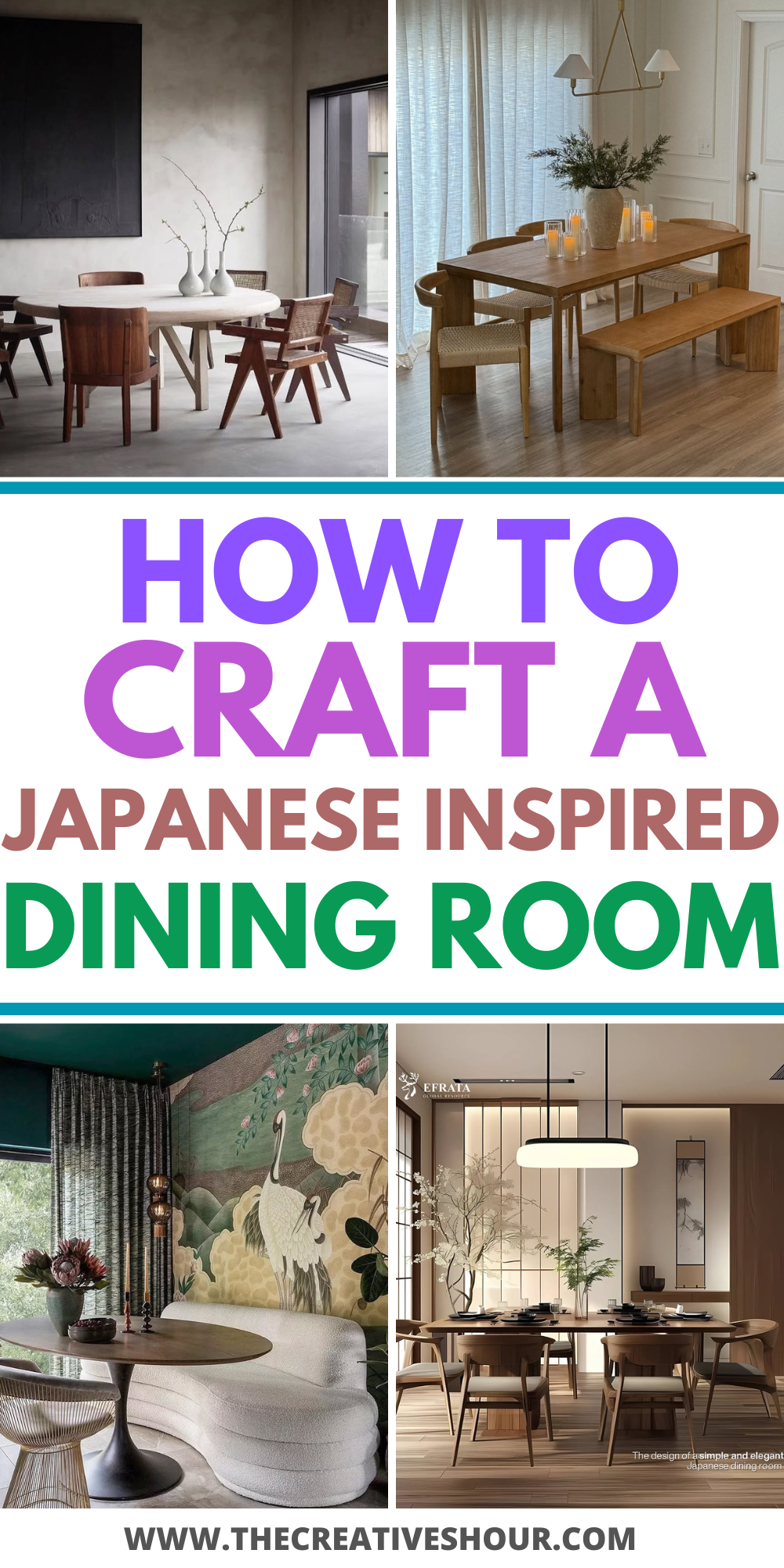
There’s a quiet elegance to Japanese interior design that has captivated design lovers around the world. Rooted in simplicity, nature, and mindfulness, this aesthetic offers more than just a visual experience—it creates a space that feels calm, intentional, and deeply grounded.
When it comes to your dining room, embracing Japanese-inspired elements can completely shift the atmosphere. It’s not just about styling a space—it’s about crafting an environment that encourages slower meals, meaningful conversations, and a deeper connection to your surroundings.
In this guide, we’ll explore 15 thoughtful design ideas to help you create a serene Japanese-inspired dining room. From natural materials and low-profile furniture to soft lighting and curated details, each tip is designed to bring balance and beauty to your everyday dining ritual.
Related Articles –
- 25 Soft And Serene Spring Dining Table Decor Ideas You Will Love
- 25 Classic And Vintage Victorian Dining Room Ideas You’ll Love
- 25 Playful And Elegant Sun Soaked Dining Room Ideas
1. Start with a Natural Color Palette
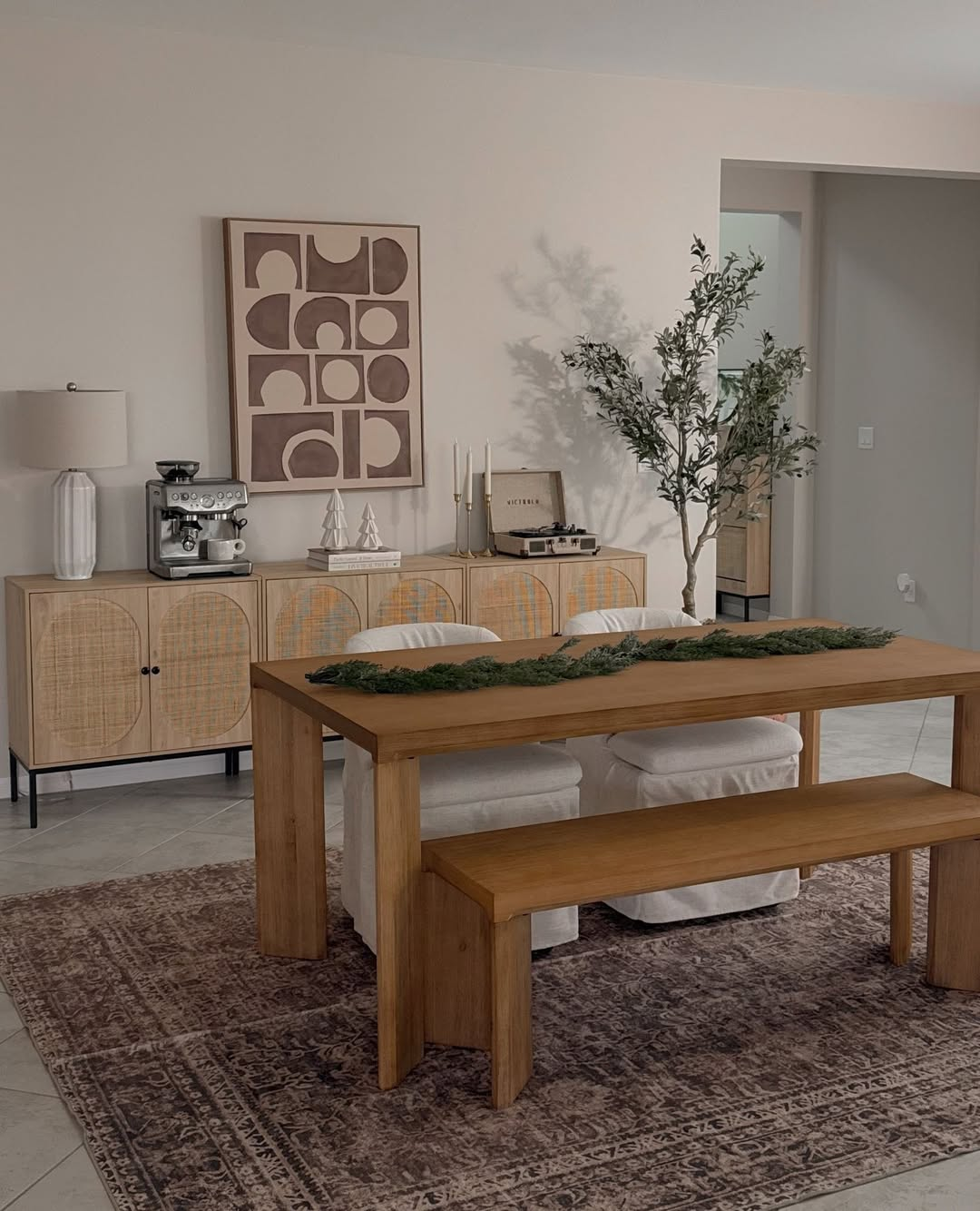
Image by castleryus
Color is one of the most powerful tools in Japanese interior design—it sets the tone for calm, balance, and harmony. A Japanese-inspired dining room begins with a natural color palette that reflects the outdoor world. Think of the soft beige of sand, the warmth of natural wood, the quiet calm of stone, and the subtle green of moss. These muted, earthy tones bring a sense of peace and grounding into the space.
Stick to colors like:
- Beige, off-white, and ivory for walls or base elements
- Warm wood browns for furniture or flooring
- Taupe or muted greys for textiles and accents
Introduce black sparingly—on chair legs, light fixtures, or picture frames—to provide contrast and structure without overwhelming the space. In Japanese aesthetics, contrast is used with intention, and even the smallest detail can offer a sense of completeness when placed with care.
By embracing these subtle hues, you create a serene canvas that allows other natural elements—like wood grain, sunlight, and greenery—to shine.
2. Incorporate Natural Materials

Image by theauburnstudio
At the heart of Japanese interior design is a deep respect for nature—and the materials it offers. In a serene Japanese-inspired dining room, every element should feel organic, grounded, and connected to the earth. Prioritize materials that are raw, unprocessed, and rich in texture.
Here are some natural materials to integrate:
- Wood: Whether you lean toward pale ash, warm oak, or deep walnut, wood is a staple. Use it for your dining table, chairs, flooring, or even exposed ceiling beams. Let the natural grain show—imperfections add character.
- Bamboo: Lightweight and sustainable, bamboo is often used in screens, placemats, or light fixtures. Its soft golden tone adds warmth without heaviness.
- Linen and Cotton: For tablecloths, runners, or seat cushions, choose textiles in breathable natural fibers. Linen, in particular, has a beautiful crumpled texture that echoes the wabi-sabi spirit.
- Rice Paper: Often used in traditional shoji screens or lanterns, rice paper diffuses light gently, creating a warm, ambient glow. It softens the space while maintaining visual lightness.
- Stone or Clay: Natural stone tiles or handmade ceramic tableware introduce an earthy grounding element. Whether polished or rough, these materials bring texture and visual interest.
Where possible, opt for handcrafted finishes over mass-produced or synthetic ones. A hand-thrown ceramic bowl or a carved wooden centerpiece brings soul to the room—something factory-made pieces simply can’t replicate.
By surrounding yourself with natural materials, you’ll create a dining room that doesn’t just look peaceful—it feels like a quiet extension of the natural world.
3. Keep the Dining Furniture Minimal
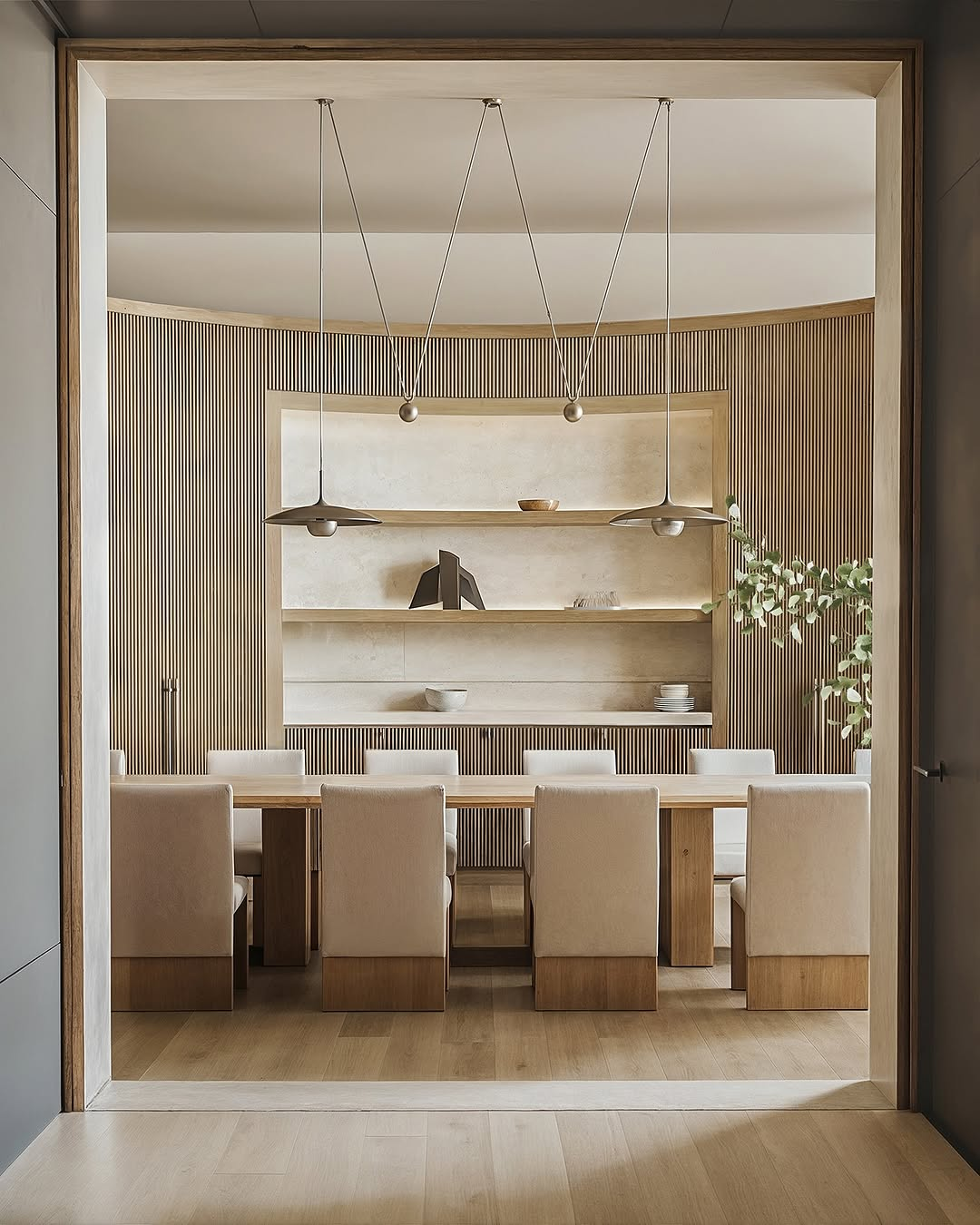
Image by noasantos
Minimalism is more than a design choice in Japanese interiors—it’s a philosophy. The dining furniture you choose should reflect that simplicity, offering functionality without excess and beauty without distraction.
Start with the dining table. Choose a low-profile design with clean, simple lines and no ornate carvings or bold finishes. Solid wood tables in natural tones work best—look for pieces that highlight the grain and texture of the wood. A rectangular or round table in ash, oak, or walnut can anchor the room while maintaining a gentle, grounded presence.
When it comes to seating, there are two primary approaches:
- Modern Japanese Style: Opt for slim, straight-backed wooden chairs in a matching or complementary wood tone. Avoid upholstered, bulky chairs that can weigh down the room.
- Traditional Style: Embrace floor seating with zabuton cushions or zaisu chairs (legless chairs with back support). This style creates an intimate, grounded dining experience and encourages mindfulness during meals.
Keep the furniture arrangement airy and functional. Avoid overcrowding the space with sideboards, bulky storage, or unnecessary accessories. If you need extra storage, consider incorporating a slim, low wooden console that can double as a tea station or minimal décor display.
The key is to honor negative space. Let the furniture breathe. This intentional spaciousness helps create the serenity and flow that are central to Japanese-inspired dining rooms.
4. Add a Tatami-Style Touch
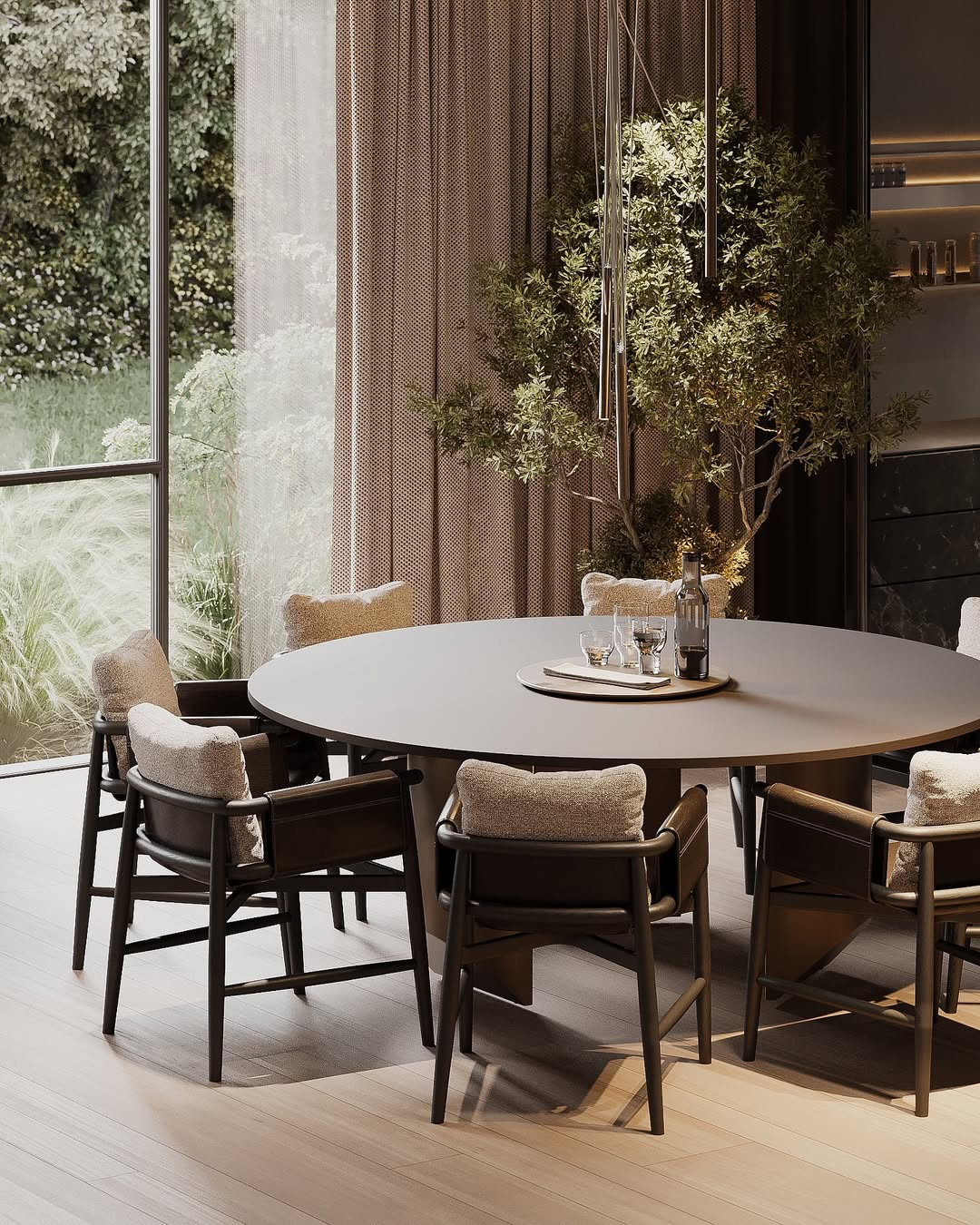
Image by hilight.design
No Japanese-inspired space feels complete without a nod to tatami—the traditional straw mats that have been used in Japanese homes for centuries. While installing authentic tatami flooring may not be practical in every home, you can still capture its essence through clever and subtle design choices.
Start by defining the dining area with a tatami-style rug. Look for floor coverings made from woven straw, jute, or natural fibers that echo the texture and look of real tatami. These mats not only add warmth and softness underfoot but also visually anchor the dining table without overwhelming the space.
For those leaning into traditional floor seating, placing zabuton cushions directly on a tatami-style mat enhances the cultural authenticity and coziness of the space.
You can also bring in the tatami aesthetic through:
- Panel detailing on walls or screens using straw or textured fabrics
- Woven placemats or runners that mimic the pattern and feel of tatami
- Natural fiber wall art in muted tones
Tatami-inspired elements serve as a gentle reminder of Japan’s deep-rooted appreciation for simplicity, grounding, and connection to the earth. They invite you to slow down, lower your energy, and approach dining with presence.
5. Create Flow with Open Space

Image by castleryus
In Japanese interior design, what’s not in the room is just as important as what is. Emptiness—referred to as ma in Japanese—is an intentional use of space that allows energy to flow freely, encourages mental clarity, and invites a sense of calm.
When designing your dining room, resist the urge to overfill. Instead, embrace negative space. Allow room around the table and between furniture pieces. This breathing room not only makes the space feel larger but also supports a sense of balance and peace during meals.
Here are some simple ways to maintain open flow:
- Choose a smaller table if your space is limited—opt for quality and proportion, not size.
- Avoid placing bulky furniture or decorative items near walkways.
- Keep decor to a minimum, and only include pieces that serve a purpose or bring joy.
- Leave some walls bare to avoid visual clutter.
If your dining area is part of an open-concept layout, create a subtle separation with a low wooden bench, area rug, or a lightweight bamboo screen—all while maintaining the visual fluidity of the space.
This open, uncluttered layout aligns with the Japanese principle of intentional living. It invites you to experience each meal mindfully, with fewer distractions and more presence.
6. Use Shoji Screens or Sliding Doors

Image by efratafurnitures
Few elements capture the essence of Japanese interiors more gracefully than shoji screens—lightweight, translucent panels made from rice paper and wooden lattice frames. In a Japanese-inspired dining room, these screens serve both functional and aesthetic purposes, offering privacy and structure while maintaining a sense of lightness and flow.
If your space allows, consider replacing heavy curtains or solid doors with:
- Shoji sliding doors that separate the dining area from the kitchen or living space
- Freestanding shoji screens used as subtle room dividers or decorative accents
- Window treatments made from rice paper or washi-style panels to soften incoming light
Unlike solid walls or thick drapery, shoji screens let natural light filter through, creating a soft glow that enhances the calm atmosphere. Their clean lines and grid patterns also add quiet visual interest without overwhelming the space.
If traditional shoji isn’t an option, you can still incorporate the aesthetic through:
- Sliding doors with frosted glass panels
- Room dividers made from wood and fabric in neutral tones
- Wall art or mirrors with shoji-inspired framing
The beauty of these elements lies in their balance of form and function—they define space while allowing openness, privacy without heaviness, and structure with softness.
7. Opt for Soft Lighting
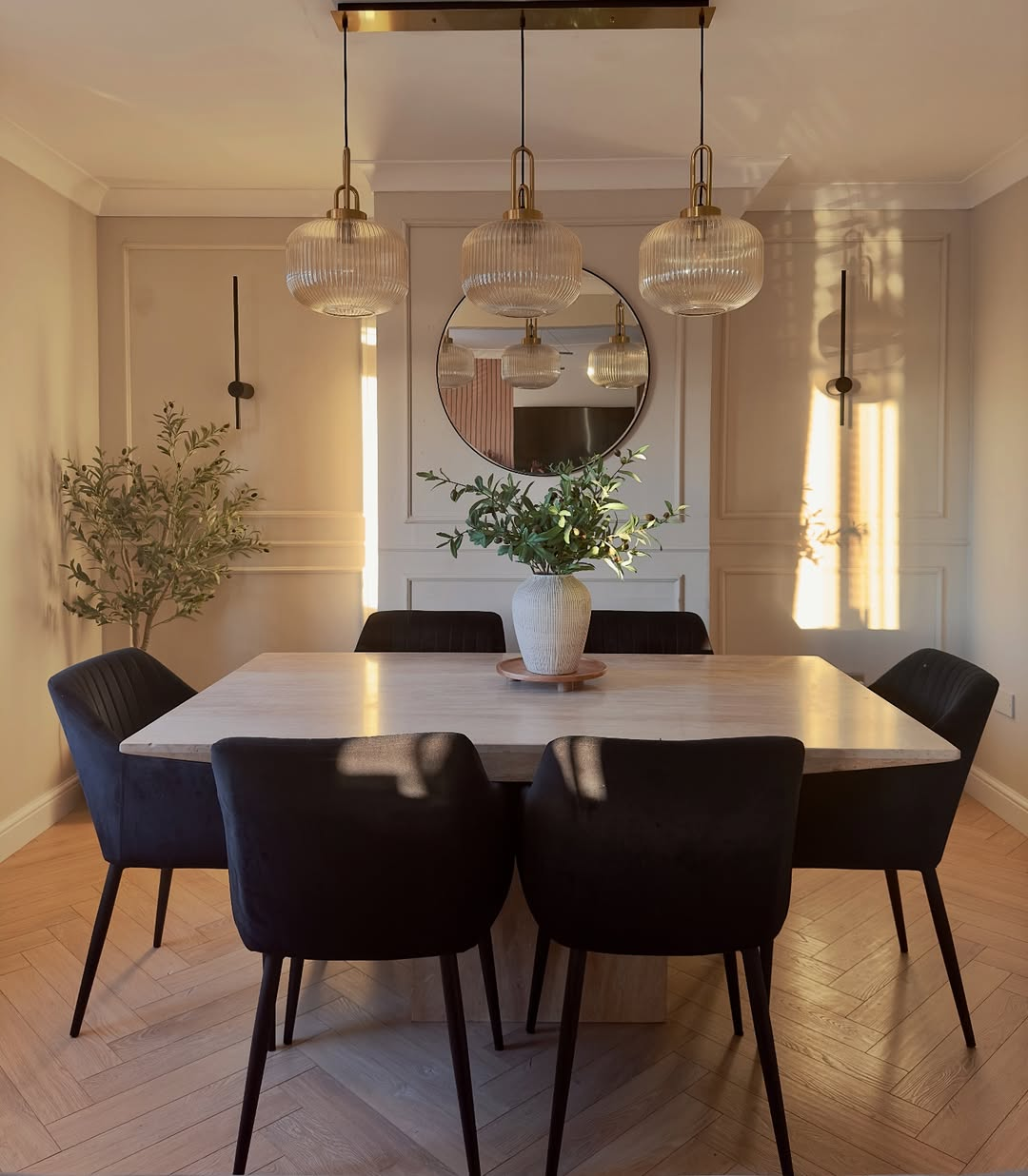
Image by number5.renovation
Lighting plays a crucial role in setting the mood of a Japanese-inspired dining room. Rather than bright, overhead lights that feel clinical or overpowering, Japanese interiors embrace warm, ambient lighting that creates a tranquil, cocoon-like atmosphere—perfect for mindful meals and slow conversations.
Start by choosing light sources that diffuse rather than spotlight:
- Paper lanterns or washi-style pendant lights are ideal—they give off a soft, natural glow and echo traditional Japanese aesthetics.
- Bamboo or rattan fixtures add organic texture and cast subtle shadows that enhance the feeling of depth.
- Wall sconces with fabric or rice paper shades can offer gentle side lighting and reduce the need for harsh ceiling lights.
To enhance the feeling of serenity, install dimmer switches to control the brightness depending on the time of day or occasion. Soft lighting encourages you to slow down, stay present, and enjoy the sensory experience of dining.
Avoid:
- Bright white or cool-toned LED lights
- Fluorescent overheads
- Overly ornate chandeliers that clash with minimalist decor
You can also supplement your main lighting with small table lamps, floor lanterns, or even candles in natural stone or ceramic holders to create layered warmth.
In a Japanese-inspired space, lighting isn’t just functional—it’s emotional. It brings calm, intimacy, and a sense of quiet reverence to the act of dining.
8. Integrate Nature with Ikebana

Image by schumacher1889
Nature holds a sacred place in Japanese design, and one of the most elegant ways to bring the outdoors into your dining room is through Ikebana—the traditional Japanese art of floral arrangement. But unlike Western floral displays, Ikebana is not about volume or flamboyance. It’s about intention, balance, and stillness.
Incorporate a small Ikebana arrangement as a centerpiece or place it on a sideboard or shelf within view of the dining table. A single curved branch, a few delicate blossoms, or even dried grasses in a ceramic vase can create a poetic, meditative focal point.
Tips for bringing Ikebana into your space:
- Use asymmetry and negative space in your arrangements to reflect natural beauty.
- Choose vessels made of stoneware, clay, or wood—nothing too glossy or overly polished.
- Reflect the seasons with your choices—cherry blossoms in spring, maple branches in autumn, pine or berries in winter.
You don’t need to follow strict Ikebana rules to benefit from its essence. Even a simple, minimalist arrangement can bring a quiet beauty that reinforces the serenity of your Japanese-inspired dining room.
This subtle connection to nature not only softens the space visually but also encourages a moment of mindfulness—a pause, an appreciation for the ephemeral beauty of each meal and season.
9. Choose Tableware with Intent
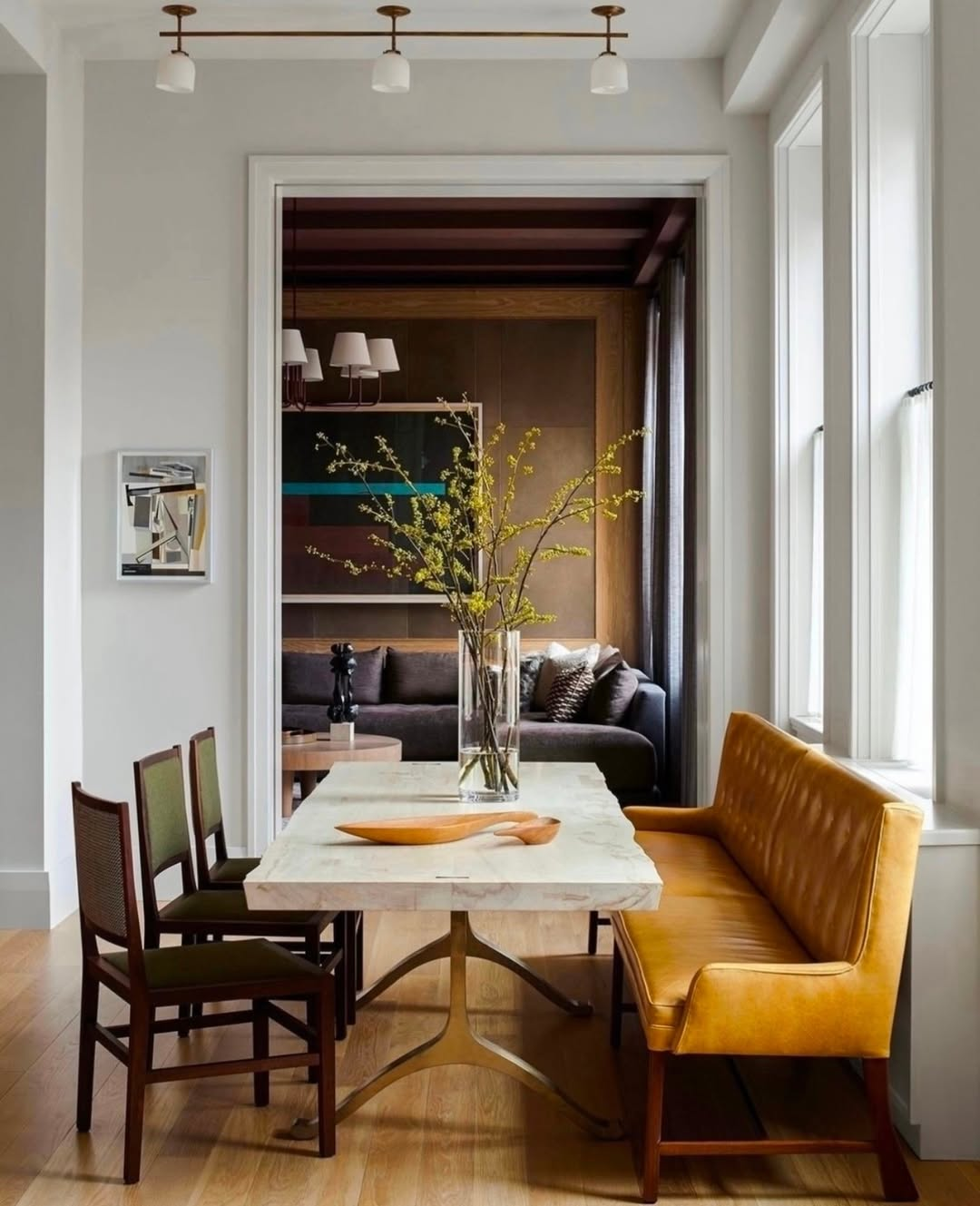
Image by altforliving
In a Japanese-inspired dining room, even the smallest detail is infused with mindfulness—and that includes your tableware. Plates, bowls, chopsticks, and serving dishes aren’t just functional; they’re part of the sensory and visual experience of a meal. Every item on the table should feel intentional, harmonious, and connected to nature.
Opt for handcrafted ceramics in earthy tones—moss green, charcoal grey, sand, or off-white. Embrace the imperfect beauty of wabi-sabi with uneven edges, subtle textures, and visible glazes. Matte finishes are especially calming and fit well with the understated aesthetic.
Suggestions for intentional tableware:
- Unglazed or partially glazed bowls and cups
- Wooden or bamboo trays and serving utensils
- Chopsticks with simple rests instead of knives and forks (if appropriate to your meals)
- Small, lidded dishes for condiments or sauces
You can even layer your tableware for visual depth—start with a wooden charger or tray, add a ceramic dinner plate, then top it with a small bowl. Use linen napkins or natural-fiber placemats to complete the look.
This approach turns every meal into a quiet ritual. The act of choosing, placing, and using these pieces becomes part of the experience—not rushed, not overlooked, but appreciated.
Remember: less is more. Instead of cluttering the table with too many pieces, curate a few beautiful, tactile essentials. In doing so, you’ll create a dining experience that feels both grounded and sacred.
10. Include a Zen-Inspired Centerpiece
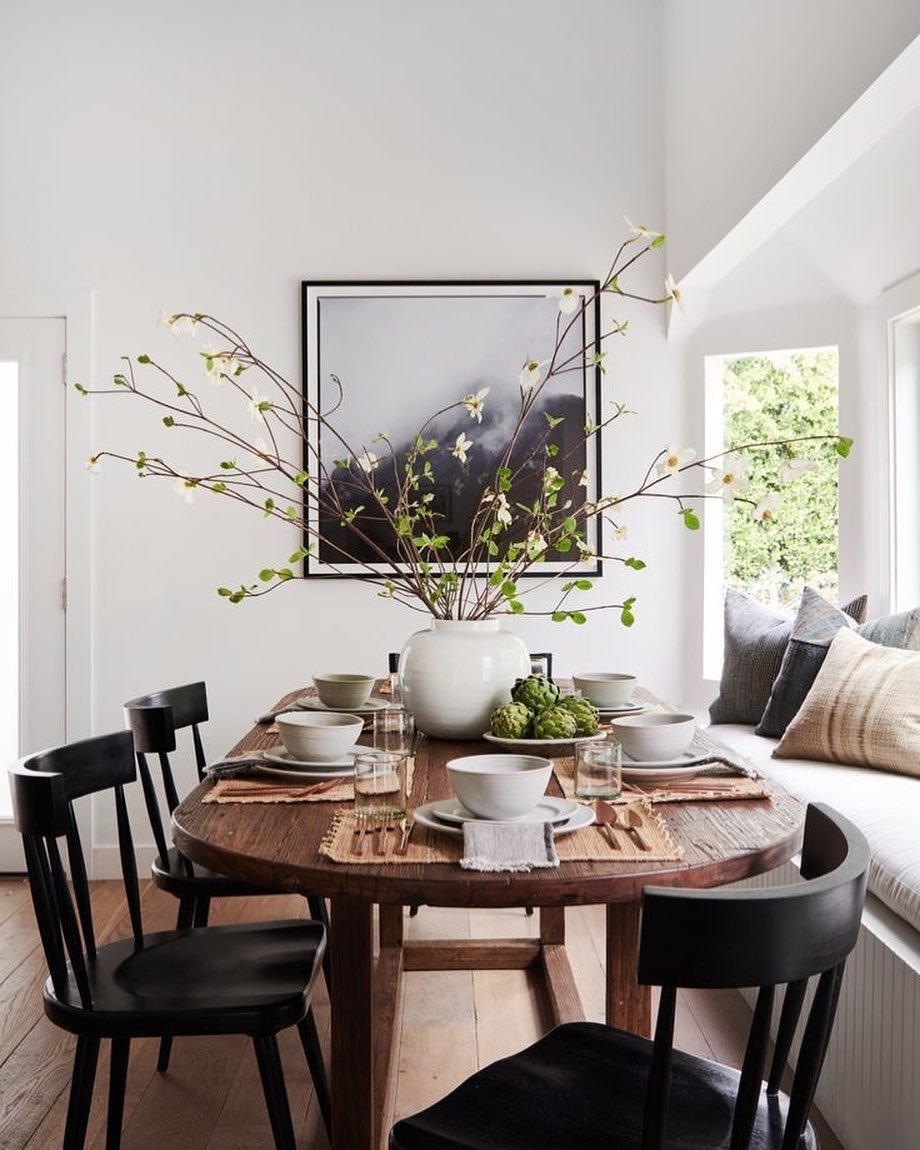
Image by ben.do.amor
A centerpiece in a Japanese-inspired dining room should feel like a moment of pause—a focal point that reflects simplicity, tranquility, and the natural world. Unlike elaborate Western centerpieces, the Japanese approach favors subtle beauty and spiritual calm. It’s not about filling space—it’s about anchoring it.
Consider these serene, Zen-inspired options:
- A miniature bonsai tree placed in a ceramic or stone planter, symbolizing patience and presence
- A shallow bowl with floating candles or a single blossom
- A small rock arrangement or a piece of driftwood, evoking the meditative quality of a Zen garden
- A hand-thrown clay vase with one or two sculptural stems or seasonal branches
The key is to keep it low, simple, and natural—nothing tall or showy that disrupts the eye line across the table. A well-chosen centerpiece should blend into the space while gently drawing attention.
To enhance the effect, pair your centerpiece with soft lighting, or place it on a linen runner in a neutral tone for added texture.
In Japanese philosophy, every element has energy. A serene centerpiece isn’t just decor—it becomes a quiet visual anchor that reinforces the room’s purpose: to slow down, nourish, and connect.
11. Let in Natural Light
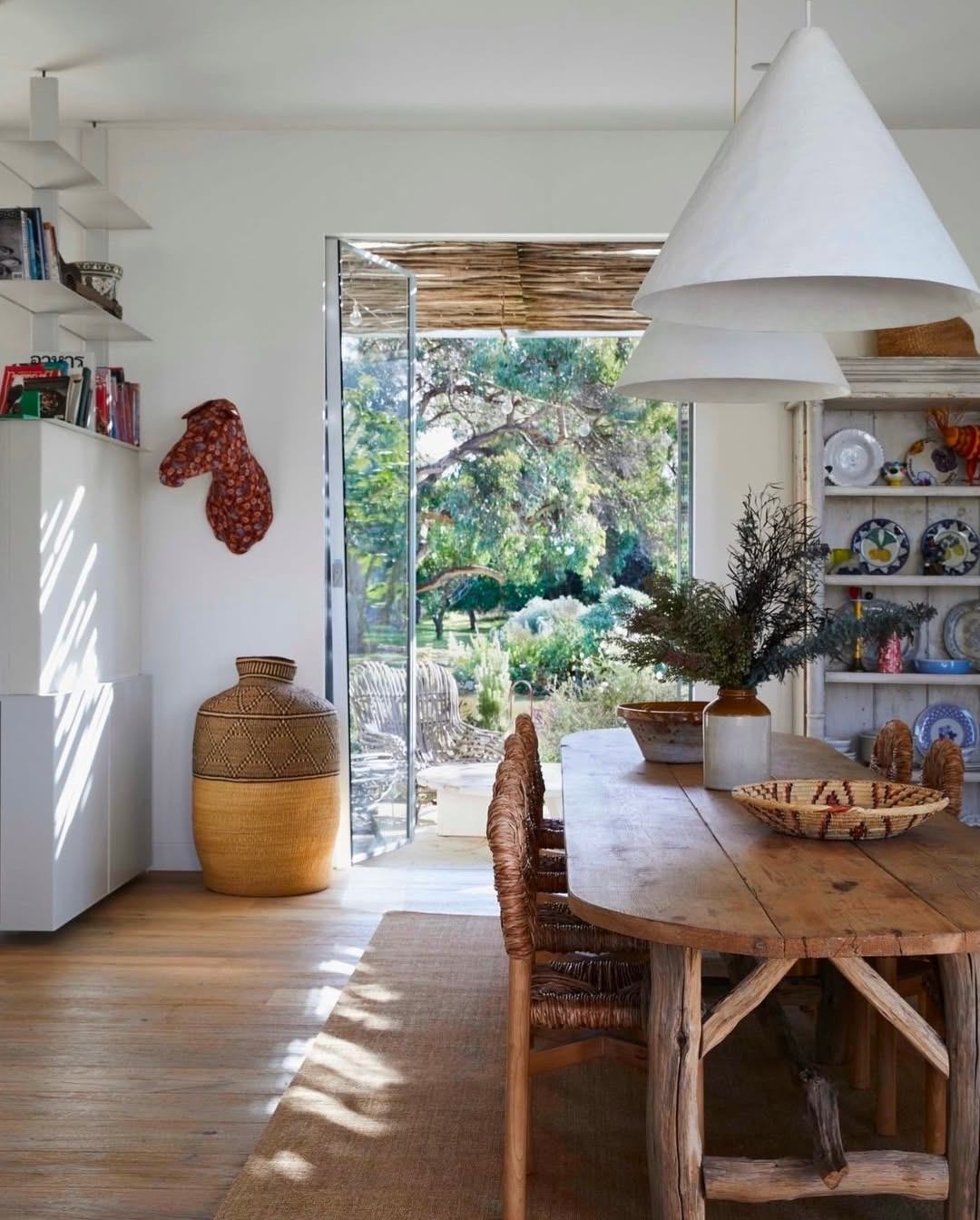
Image by altforliving
Natural light is one of the most cherished elements in Japanese design. It’s not just about brightness—it’s about the gentle, shifting relationship between light and shadow throughout the day. In a Japanese-inspired dining room, the goal is to invite light in and let it interact softly with the materials and textures in the space.
To maximize natural light:
- Keep windows unobstructed whenever possible. Avoid heavy drapes or dark blinds.
- Use sheer linen or cotton curtains in soft neutral tones if privacy is needed—they filter light without blocking it.
- Choose light-reflecting materials like rice paper, pale woods, or matte ceramics that help disperse light gently.
- Position your dining table near a window or sliding door to allow natural light to enhance mealtime rituals.
Light in Japanese interiors isn’t meant to flood the space aggressively—it’s meant to whisper, to gently illuminate surfaces, and to create moments of reflection as the sun moves across the sky.
Bonus tip: If your space lacks abundant natural light, simulate its warmth with soft ambient lighting, warm-toned bulbs, or wall sconces that mimic the diffused glow of morning light.
Letting in natural light not only enhances visual harmony—it uplifts the mood of the room and helps your dining area feel connected to the natural world beyond the walls.
12. Embrace Wabi-Sabi Imperfection
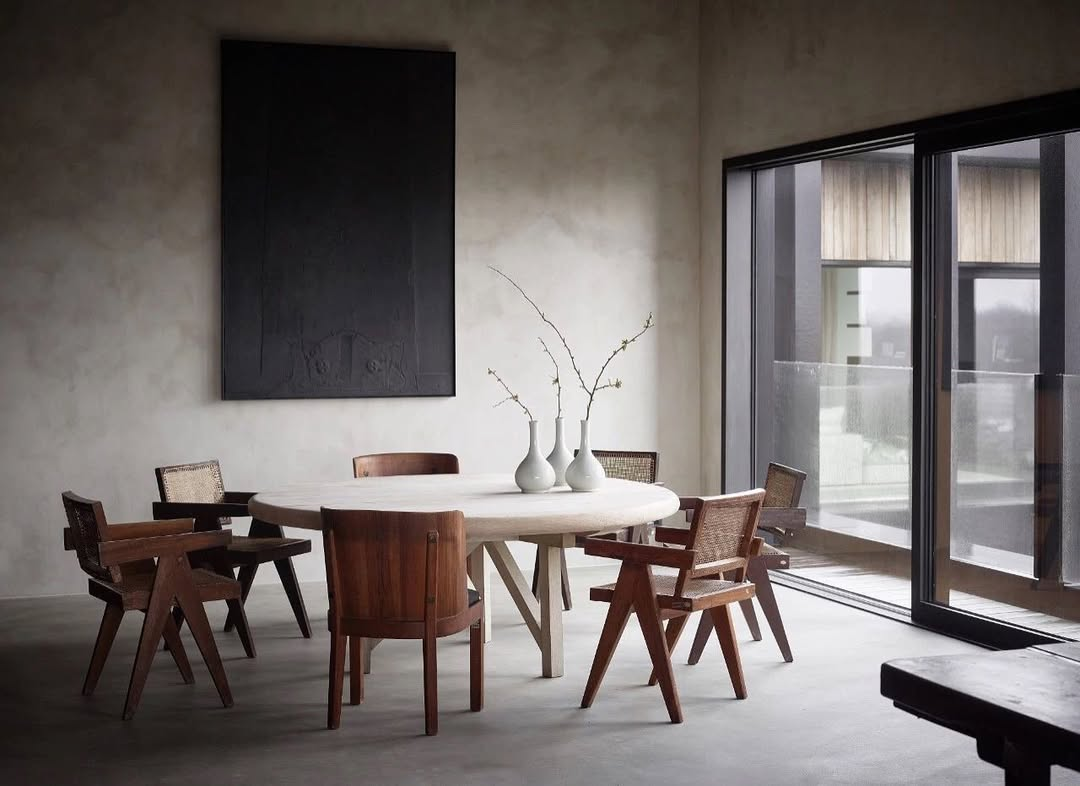
Image by do.pe.design
At the core of Japanese design lies wabi-sabi—a philosophy that celebrates the beauty of imperfection, impermanence, and authenticity. It invites you to find grace in the natural wear of materials, the asymmetry of handmade objects, and the quiet charm of things that feel lived-in rather than pristine.
In your dining room, embracing wabi-sabi means letting go of perfection and choosing pieces that carry soul over polish. Instead of matching dining sets or glossy surfaces, look for items with:
- Visible grain in wood furniture
- Cracks or uneven glazing in ceramics
- Frayed edges or natural wrinkles in linen textiles
- Patina on metal or stoneware that has aged with time
Rather than hiding flaws, wabi-sabi teaches you to see them as marks of beauty and character. A slightly chipped bowl, a weathered wooden bench, or a hand-thrown vase with an off-center shape all add depth and story to your space.
You can also reflect wabi-sabi in how you style your dining room:
- Leave some corners bare to honor negative space
- Mix old and new pieces with ease
- Avoid over-styling—let things be simple, honest, and a little undone
This approach makes your dining room feel not only serene, but real—a place where beauty and imperfection can coexist naturally, just like in life.
13. Add Texture with Linen or Cotton
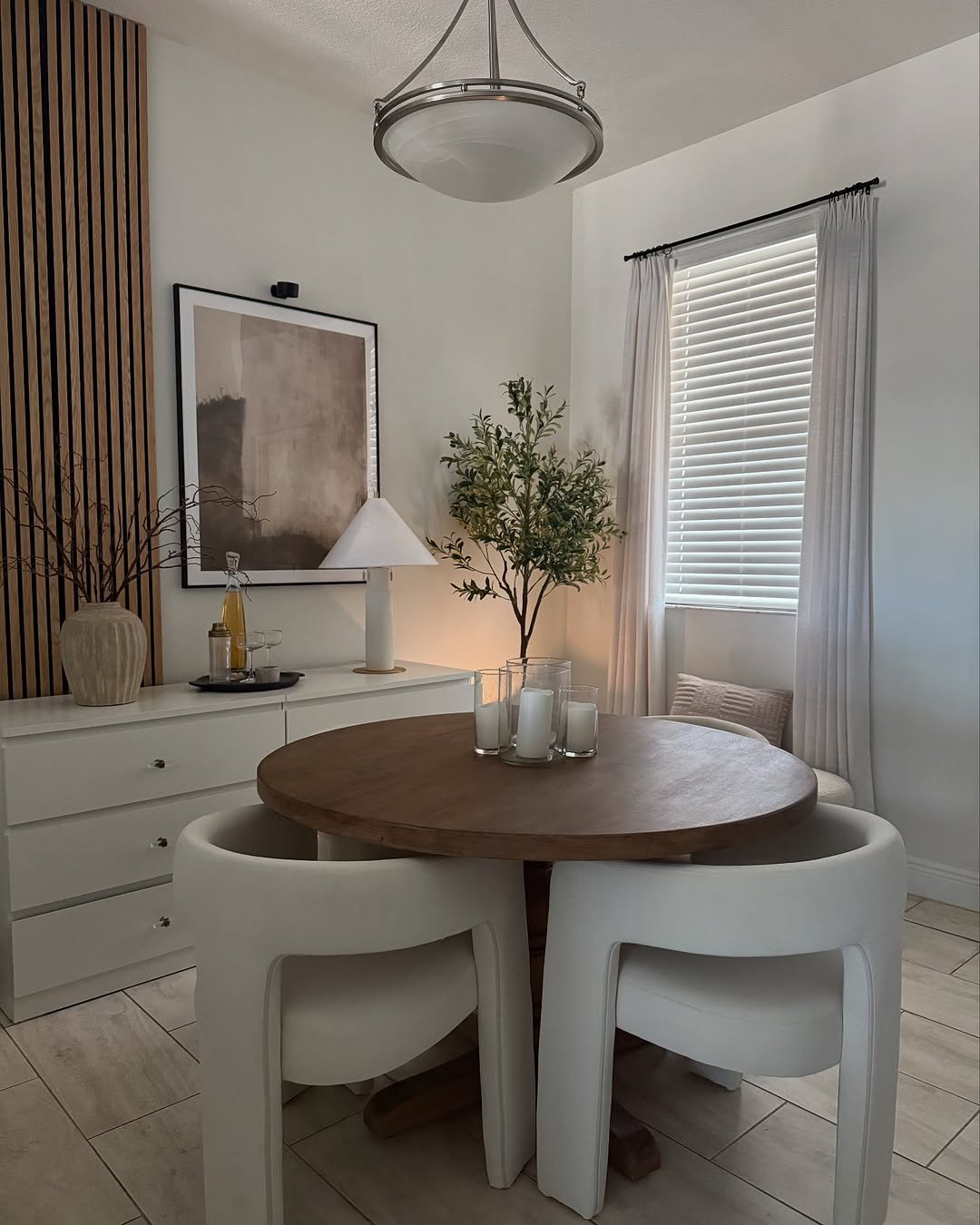
Image by homewithyoshi
While Japanese-inspired interiors are often minimalist in design, they are far from cold or sterile. The secret lies in the layering of natural textures—especially through soft, breathable fabrics like linen and cotton. These textiles add a tactile richness that invites comfort while staying true to the organic, grounded aesthetic.
In your dining room, incorporate linen or cotton through:
- Table runners or tablecloths in muted, earthy tones
- Fabric napkins neatly folded or casually draped for a lived-in look
- Seat cushions or slipcovers in natural weaves
- Curtains or blinds made from lightweight, unbleached cotton or linen
Linen, in particular, embodies the wabi-sabi spirit—it wrinkles easily, but those soft creases are part of its charm. The fabric ages beautifully over time, becoming softer and more relaxed with each use.
When choosing your textiles:
- Stick to neutral colors like cream, beige, stone, or soft greys
- Avoid synthetic fabrics or overly bright patterns
- Embrace slightly imperfect or raw edges for added authenticity
These subtle textures bring warmth and softness to the structured lines of wood and stone, creating a harmonious balance. It’s a quiet layering that doesn’t demand attention but contributes greatly to the overall serenity of the space.
14. Display Art Sparingly
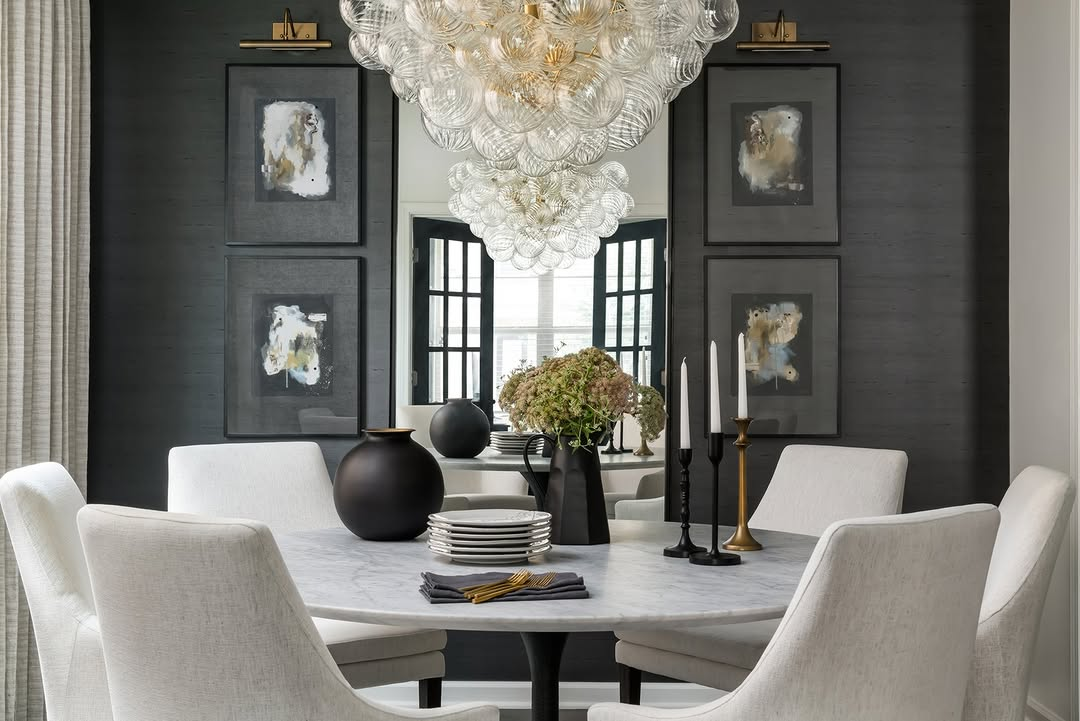
Image by phillipjeffriesltd
In a Japanese-inspired dining room, less is truly more—especially when it comes to art. Walls aren’t meant to be filled, but rather respected as part of the space. The goal is not to overwhelm the eye, but to offer quiet, intentional moments of beauty that enhance the room’s overall serenity.
Instead of creating a gallery wall or cluttering shelves, consider displaying one or two carefully chosen pieces that reflect simplicity and meaning. Think:
- A single calligraphy scroll with a Japanese proverb or character
- A sumi-e ink painting of bamboo, cranes, or mountains
- A minimalist nature print in soft black and white
- A piece of handmade pottery or sculptural wood displayed on a ledge
When placing art:
- Leave generous amounts of negative space around the piece
- Hang it at eye level or slightly lower for a grounded, meditative feel
- Use natural wood frames or keep the framing minimal and unobtrusive
You can also treat objects as art—a beautifully glazed ceramic bowl, a dried branch in a vase, or a folded linen cloth can all act as visual poetry when styled with care.
By displaying art sparingly, you allow each piece to breathe and speak for itself. It invites contemplation rather than consumption—turning your dining room into a space where silence and subtlety are part of the beauty.
15. Maintain Clean Lines and Order
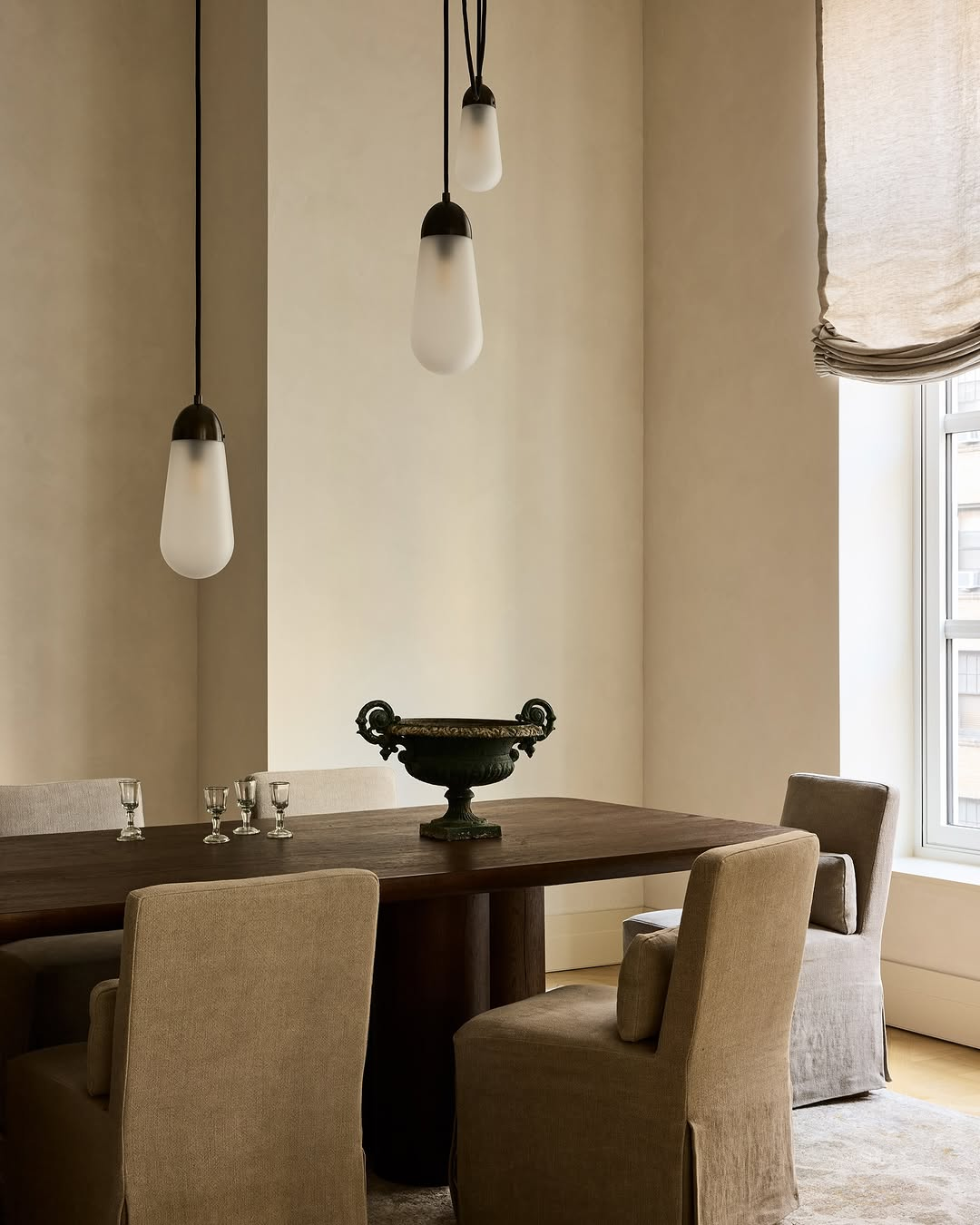
Image by katie_harbison
A serene Japanese-inspired dining room is defined not just by what’s in it—but by how it’s arranged. Clean lines and a sense of order are essential to creating the peaceful, clutter-free environment that characterizes Japanese interiors. When everything has its place, the space becomes more than functional—it becomes meditative.
Begin with the architecture of the room:
- Choose furniture with simple, straight lines—no ornate curves or bulky profiles.
- Arrange pieces with intentional spacing between them to allow light and energy to flow.
- Keep edges and surfaces unobstructed, whether it’s a sideboard, window sill, or tabletop.
Organization is just as important as visual design. To maintain clarity:
- Store dining essentials like tableware, placemats, and napkins in a concealed drawer or minimalist cabinet.
- Use baskets or wooden boxes to keep necessary items out of sight but easily accessible.
- Avoid open shelves that attract clutter—if you do use them, display only a few curated items.
Every element in the room should feel thoughtfully placed, not randomly added. This doesn’t mean the room should feel rigid—it should feel balanced, with just enough detail to spark visual interest without creating chaos.
Ultimately, maintaining clean lines and order allows the more subtle elements—texture, light, and material—to shine. It creates a dining space where your mind can rest, your senses can breathe, and your meals can be savored with intention.
Final Thoughts
Creating a serene Japanese-inspired dining room isn’t about buying all new furniture or following trends—it’s about embracing a mindful way of living. Through natural materials, clean lines, calming colors, and thoughtful simplicity, you can design a space that nourishes more than just your appetite.
Start small. Add a linen runner, bring in a branch arrangement, or clear the clutter from your table. Each intentional step brings you closer to a dining room that feels like a quiet retreat—a space where beauty, balance, and calm are always present.
In true Japanese fashion, let your space evolve naturally, honoring the process as much as the result. Over time, you’ll find that this room becomes more than a place to eat—it becomes a place to pause, connect, and just be.
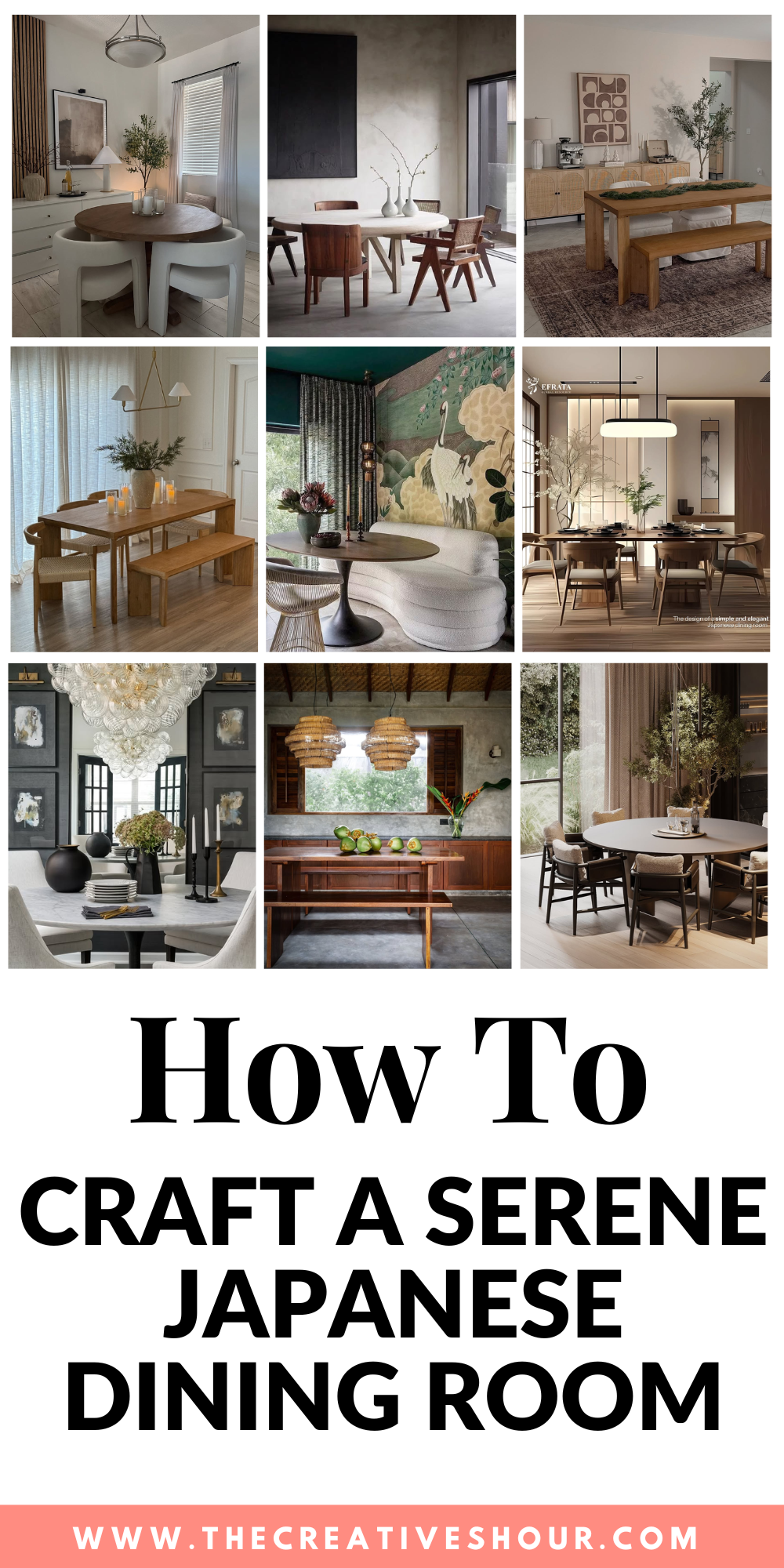
If you love these tips, don’t forget to pin the above image to your “Home and Garden” board.
